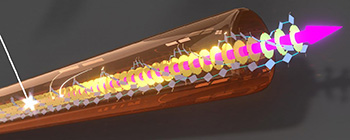
Credit: A.T. Haedler, University of Bayreuth
Capturing energy from the sun is just the beginning; to be useful, the energy must be transported to another place with the least loss possible. Physicists and chemists at two German institutions have demonstrated room-temperature exciton transport over distances two orders of magnitude longer than in previous experiments (Nature, doi:10.1038/nature14570).
The exciton transport, carried out over self-assembled nanofibers, appears limited only by the length of the fiber, according to the teams at the universities of Bayreuth and Erlangen-Nuremburg. The ability to move energy across tiny distances could help power future organic nanophotonic devices.
The finding comes from the world of supramolecular chemistry, in which molecules combine through noncovalent interactions to build structures that can carry out more tasks than the individual molecules themselves. In this case, the building blocks of the nanofibers consisted of a core of carbonyl-bridged triarylamine (CBT) with three branches consisting of chromophoric amides. The molecular diagram of this structure looks something like a triskele.
When immersed in a gel under the right conditions, these tiny structures stack themselves up to form fibers roughly 5 nm wide. The German teams confirmed these structures by studying their absorption spectra and photoluminescence. Then the scientists isolated 97 individual fibers, each roughly 4 µm long, and recorded the energy transport down the length of each fiber. In most previous experiments, excitons had traveled only 10 to 50 nm; to get longer transport distances, the medium had to be cooled to 10 K.
The researchers believe that electronic coupling between neighboring CBT units helps make the exciton transport possible and that the transport is predominantly coherent. This method could someday carry energy from a light-harvesting antenna to a transducer in a nanoscale electronic device.
